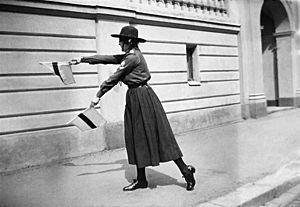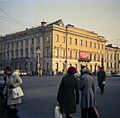Berit Wallenberg facts for kids
Quick facts for kids
Berit Wallenberg
|
|
|---|---|
 |
|
| Born |
Anna Berit Wallenberg
19 February 1902 Stockholm, Sweden
|
| Died | 4 September 1995 (aged 93) Ekerö, Sweden
|
| Occupation | Archaeologist, anthropologist, photographer, art historian |
| Relatives | André Oscar Wallenberg (grandfather) |
Anna Berit Wallenberg (born February 19, 1902 – died September 4, 1995) was a famous Swedish archaeologist, anthropologist, and art historian. She was also a talented photographer and a generous person who helped others (a philanthropist).
Berit Wallenberg created the Berit Wallenberg Foundation. This foundation gives money to support research in archaeology and art history. It helps cultural heritage groups, art historians, and archaeologists. In 1936, she made history as the first Swedish woman to supervise the national heritage committee. She helped restore the beautiful Lovö church.
She was the only woman to receive an honorary doctorate from Stockholm University. Berit spent her life studying history, especially local history. She worked hard to protect old buildings and important sites. Her work combined science, her Christian faith, and a love for local history. This was especially true around Drottningholm Island and Lovön.
Berit took part in many archaeological digs. She even found a self-portrait by Albertus Pictor, a famous medieval Swedish painter, in Lids Church. She photographed many important places and monuments. Her pictures are still used today in history and archaeology studies. Her collection of about 25,000 photos was given to the Swedish National Heritage Board. She hoped they would be useful for future researchers.
Contents
Early Life and Family History
Berit Wallenberg was born on February 19, 1902. Her birthplace was in Skeppsholm parish, Stockholm. Her father was Oscar Wallenberg, a naval officer and businessman. Her mother was Beatrice Keiller. Berit's grandfather was André Oscar Wallenberg, who started the Stockholms Enskilda Bank. She was also a cousin to Raoul Wallenberg's father.
Berit grew up with her brother, Carol. They lived in Villastaden, Stockholm, where many important business people lived. The family also spent time in Särö, where her mother grew up. They had a summer home in Lovön, Drottningholm.
Her Education Journey

In 1922, when she was 20, Berit decided to study art history. She learned Latin to get into high school, even though her parents didn't want her to at first. But her father later supported her studies. In 1925, she finished school at the Nya Elementarskolan för flickor in Stockholm.
Later that year, she went to Stockholm University. She studied archaeology and art history. Her studies covered ancient Northern Europe, Cyprus, and China. She also learned about ethnology, which is the study of cultures. Berit became an expert in medieval paintings (frescoes) from Finland, Denmark, and Sweden. In 1931, she earned her licentiate degree in archaeology. She also got a diploma from the Byzantine Institute in Ravenna, Italy. In 1942, she earned another degree in art history and archaeology from Stockholm University.
Her Amazing Career
Archaeology Discoveries
Berit Wallenberg took part in many archaeological digs while she was a student. In 1924, she helped excavate a Bronze Age site in Laholm. She also worked at the heathen temple in Gamla Uppsala in 1926. From 1927 to 1930, she participated in four digs at the Alvastra convent church and Vendel church. During the Alvastra dig, she met fellow archaeologist Greta Arwidsson.
In 1927, Berit found the long-lost graves of the Sverker family. In 1935, she became deeply involved in restoring the Lovö church. Her hard work was noticed by Sigurd Curman, who led the National Heritage Board. She was chosen for the board, becoming the first Swedish woman to join. Her contributions were far beyond what was expected.
In 1939, Berit led a dig of four tombs under the rune cliffs of Skänninge. This was done for the Gotland Museum and the National Heritage Committee. Over the years, she worked on many digs, especially around Stockholm. She created many documents and took countless photographs during her travels. She collected pictures of old buildings and areas in Europe that were destroyed in World War II. These images and her descriptions help us remember this lost cultural heritage. She gave many of her photos to the Heritage Board in the 1980s.
Helping Others (Philanthropy)
On November 19, 1955, Berit Wallenberg started the Berit Wallenberg Foundation. She donated 406,000 Swedish kronor to begin it. The foundation supports research in archaeology and art history. It mainly helps studies about Swedish and Nordic history up to the late 1800s.
Her Photography Work
Berit Wallenberg started taking pictures when she was young. She gave her collection of about 25,000 photographs to the National Heritage Board in the 1980s. She hoped they would be used for future research. The Swedish National Heritage Board has digitized some of her pictures. This was made possible by a grant from her foundation.
Her photos were taken from the 1920s to the 1980s. Most are in black and white. The pictures show her interests as an archaeologist and art historian. She photographed ancient sites, digs, churches, and old paintings (frescoes). She also captured buildings, city scenes, and landscapes. Many photos were taken during her study trips to Europe in the 1920s and 1930s.
She traveled to the Nordic countries, France, Belgium, the Netherlands, Germany, Italy, the United Kingdom, Ireland, and Russia. In 1930, Berit visited Þingvellir, Iceland. She took many photos of the 1000th anniversary of the national parliament, Althing. Other photos show her personal life. These include pictures with schoolmates, family, and friends. She also photographed scout activities, Christmas, and holidays. Her photos show her homes and an international student meeting in Iceland.
Wallenberg's photographs are very important historical records. They show places and buildings that no longer exist or have changed a lot. For example, she photographed German cities before World War II.
Her Personal Life
Berit Wallenberg never married. Her life was shaped by her family, friends, and religious beliefs. She was an active missionary and wrote newspaper columns. She also wrote a cantata, which is a type of musical piece. Her friends included religious leaders and other important people.
Several close friends were important in her work and personal life. These included writer Stina Ridderstad and Dean Gustaf Brunkrona. She was also friends with Gerda Boëthius, who directed an art museum. Her friendships with archaeologist Greta Arwidsson and art historian Agnes Geijer lasted until her death.
Her Passing
Berit Wallenberg passed away on September 4, 1995. She was buried in Lovö Church on September 14. This was where many of her family members were also buried. A priest named Lars Djerf buried her. He later wrote a book about her life in 2003.
Her Lasting Impact
Berit Wallenberg dedicated her life to research, local history, and protecting old sites. Her scientific knowledge, Christian faith, and local history work were very important to her. This was especially true for Drottningholm Island and Lovön.
She donated many photographs and documents to museums and archives. These are still used in historical research today. Her photos are valuable records of the past. They show places and buildings that have changed or no longer exist. This makes them very useful for historical and archaeological studies. Her foundation continues to support cultural heritage groups, art historians, and archaeologists.
Awards and Special Recognitions
- Illis quorum (1952)
- Honorary doctorate of philosophy from Stockholm University
- Hazelius medal in silver by Nordiska museet (1973)
- Honorary membership of the S:ta Ingrids Gille local history association (1940)
- Commendation award by Samfundet för hembygdsvård (SfH)
Images for kids
-
"Bergshammars kyrka" Bell tower at Bergshammar church, Södermanland, Sweden, 1928
-
"Risinge gamla kyrka", Risinge old church, Finspång Municipality, Sweden, 1933
-
La Grande Boucherie, the medieval butchers' hall at Groentenmarkt in Gent, Belgium, 1934
-
"Gent", Belgium, 1934
-
"Belgian manoeuvre" in Tournai, Belgium, 1934
-
Alignments of standing stones at Ménec in Carnac in Brittany, France, 1937
-
"Anundshögsområdet" Västerås Municipality, Sweden, 1939
-
"Leningrad", Russia, Soviet Union, 1971
















